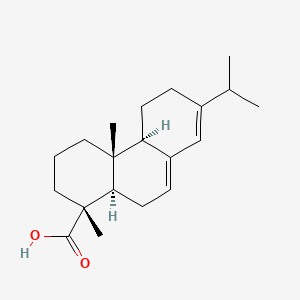| MeSH term | MeSH ID | Detail |
|---|---|---|
| Asthma | D001249 | 52 associated lipids |
| Cell Transformation, Neoplastic | D002471 | 126 associated lipids |
| Dermatitis, Contact | D003877 | 59 associated lipids |
| Edema | D004487 | 152 associated lipids |
| Occupational Diseases | D009784 | 42 associated lipids |
| Psoriasis | D011565 | 47 associated lipids |
| Ulcer | D014456 | 16 associated lipids |
| Weight Gain | D015430 | 101 associated lipids |
Abietic acid
Abietic acid is a lipid of Prenol Lipids (PR) class. Abietic acid is associated with abnormalities such as Hand eczema, Dermatitis, Vitelliform dystrophy, Wiskott-Aldrich Syndrome and Dehydration. The involved functions are known as Process, Oxidation, Anabolism, Transmembrane Transport and physiological aspects. Abietic acid often locates in Membrane, Protoplasm, Microsomes and Cellular Membrane. The associated genes with Abietic acid are SLC33A1 gene and ABCG2 gene. The related lipids are Pinene.
Cross Reference
Introduction
To understand associated biological information of Abietic acid, we collected biological information of abnormalities, associated pathways, cellular/molecular locations, biological functions, related genes/proteins, lipids and common seen animal/experimental models with organized paragraphs from literatures.
What diseases are associated with Abietic acid?
Abietic acid is suspected in Hand eczema, Dermatitis, Dehydration and other diseases in descending order of the highest number of associated sentences.
Related references are mostly published in these journals:
| Disease | Cross reference | Weighted score | Related literature |
|---|
Possible diseases from mapped MeSH terms on references
We collected disease MeSH terms mapped to the references associated with Abietic acid
PubChem Associated disorders and diseases
What pathways are associated with Abietic acid
There are no associated biomedical information in the current reference collection.
PubChem Biomolecular Interactions and Pathways
Link to PubChem Biomolecular Interactions and PathwaysWhat cellular locations are associated with Abietic acid?
Visualization in cellular structure
Associated locations are in red color. Not associated locations are in black.
Related references are published most in these journals:
| Location | Cross reference | Weighted score | Related literatures |
|---|
What functions are associated with Abietic acid?
Related references are published most in these journals:
| Function | Cross reference | Weighted score | Related literatures |
|---|
What lipids are associated with Abietic acid?
Related references are published most in these journals:
| Lipid concept | Cross reference | Weighted score | Related literatures |
|---|
What genes are associated with Abietic acid?
Related references are published most in these journals:
| Gene | Cross reference | Weighted score | Related literatures |
|---|
What common seen animal models are associated with Abietic acid?
There are no associated biomedical information in the current reference collection.
NCBI Entrez Crosslinks
All references with Abietic acid
Download all related citations| Authors | Title | Published | Journal | PubMed Link |
|---|---|---|---|---|
| Hwang KH et al. | Abietic acid has an anti-obesity effect in mice fed a high-fat diet. | 2011 | J Med Food | pmid:21812648 |
| Lardos A et al. | Resins and Gums in Historical Iatrosophia Texts from Cyprus - A Botanical and Medico-pharmacological Approach. | 2011 | Front Pharmacol | pmid:21772820 |
| Frija LM et al. | Isolation, chemical, and biotransformation routes of labdane-type diterpenes. | 2011 | Chem. Rev. | pmid:21618966 |
| Rao XP | N-Morpholino-Δ-dihydro-abietamide. | 2010 | Acta Crystallogr Sect E Struct Rep Online | pmid:21588936 |
| Wang K et al. | Methyl 7-oxo-12-propyl-amino-13-nitro-deisopropyl-dehydro-abietate. | 2010 | Acta Crystallogr Sect E Struct Rep Online | pmid:21587581 |
| Zhang M et al. | 13-Ethoxy-carbonyl-16-(1-methyl-ethyl)-17,19-dinoratis-15-ene-4,14-dicarboxylic acid monohydrate: a new derivative of maleopimaric acid. | 2009 | Acta Crystallogr Sect E Struct Rep Online | pmid:21583637 |
| Zhang M et al. | Maleopimaric acid acetic acid solvate. | 2009 | Acta Crystallogr Sect E Struct Rep Online | pmid:21582965 |
| Siebert MR et al. | The need for enzymatic steering in abietic acid biosynthesis: gas-phase chemical dynamics simulations of carbocation rearrangements on a bifurcating potential energy surface. | 2011 | J. Am. Chem. Soc. | pmid:21548620 |
| Bleif S et al. | Identification of CYP106A2 as a regioselective allylic bacterial diterpene hydroxylase. | 2011 | Chembiochem | pmid:21271628 |
| Gören AC et al. | Chemical composition of natural colophony from Pinus brutia and comparison with synthetic colophony. | 2010 | Nat Prod Commun | pmid:21213968 |
| pmid:21146981 | ||||
| Boskabady MH et al. | Work-related respiratory symptoms and pulmonary function tests in northeast iranian (the city of Mashhad) carpenters. | 2010 | Clinics (Sao Paulo) | pmid:21120301 |
| Ehrin E and Karlberg AT | Detection of rosin (colophony) components in technical products using an HPLC technique. | 1990 | Contact Derm. | pmid:2096025 |
| Hausen BM et al. | Contact allergy due to colophony (VII). Sensitizing studies with oxidation products of abietic and related acids. | 1990 | Contact Derm. | pmid:2096024 |
| Goto T et al. | Various Terpenoids Derived from Herbal and Dietary Plants Function as PPAR Modulators and Regulate Carbohydrate and Lipid Metabolism. | 2010 | PPAR Res | pmid:20613991 |
| pmid:20583317 | ||||
| Abbott E et al. | Laser microdissection of conifer stem tissues: isolation and analysis of high quality RNA, terpene synthase enzyme activity and terpenoid metabolites from resin ducts and cambial zone tissue of white spruce (Picea glauca). | 2010 | BMC Plant Biol. | pmid:20540781 |
| Söderberg TA et al. | Antibacterial effects of zinc oxide, rosin, and resin acids with special reference to their interactions. | 1991 | Scand J Plast Reconstr Surg Hand Surg | pmid:2052904 |
| Hirai S et al. | Functional food targeting the regulation of obesity-induced inflammatory responses and pathologies. | 2010 | Mediators Inflamm. | pmid:20508825 |
| Kim NH et al. | Tetrahydroabietic Acid, a Reduced Abietic Acid, Inhibits the Production of Inflammatory Mediators in RAW264.7 Macrophages Activated with Lipopolysaccharide. | 2010 | J Clin Biochem Nutr | pmid:20216944 |
